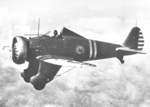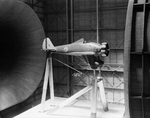P-26 Peashooter
| Country | United States |
| Manufacturer | The Boeing Company |
| Primary Role | Fighter |
| Maiden Flight | 20 March 1932 |
Contributor: C. Peter Chen
ww2dbaseIn Sep 1931, the Boeing Company started the project known internally in the company as Model 248 in cooperation with the United States Army Air Corps. The first prototype, XP-936, took flight in Mar 1932. After additional tweaks in the design to address issues such as high landing accident rates, the resulting open-cockpit, fixed landing gear, all-metal monoplanes was accepted by the USAAC under the designation P-26 Peashooter. Deliveries began in Dec 1933, and by 1936 six squadrons flew the P-26 fighters.
ww2dbaseBoeing also produced export versions of the aircraft; 1 was sold to Spain and 11 were sold to China in the mid-1930s. The aircraft purchased by Spain was the first P-26 Peashooter fighter to see combat, but it was shot down in 1936 during the Spanish Civil War without seeing any success. Those operated by the Republic of China Air Force would take that honor in 1937 as China and Japan engaged in the very first chapters of WW2; on 15 Aug 1937, 8 P-26 fighters of the 17th Squadron of the Chinese 3rd Pursuit Group based at Chuyung Airfield near the capital of Nanjing engaged 8 G3M medium bombers of the Japanese Kisarazu Air Group, shooting down 2 of the 4 Japanese bombers lost during this attack that also marked the first monoplane dogfight over Asia.
ww2dbaseIn 1938, the USAAC began removing P-26 Peashooter from front line service within the United States. Rather than being retired, they were shipped to squadrons based in the US Territory of Hawaii, the Philippine Islands, and the Panama Canal Zone. Some of them would continue to be in service by the time the United States entered WW2 in Dec 1941; at that time, 12 of them were in operational service with the Philippine Army Air Corps, 9 with the USAAC at the Panama Canal Zone, and 7 with the USAAC in Hawaii. During the Japanese invasion of the Philippine Islands, Filipino P-26 fighters shot down one G3M bomber and two or three A6M2 Zero fighters; all surviving P-26 fighters at the end of that campaign were destroyed by their own crews before the end of 1941 to prevent Japanese capture.
ww2dbaseBetween 1942 and 1943, the Guatemalan Air Force purchased unarmed P-26 fighters from the United States. They remained in service until 1956, becoming the last P-26 fighters to be retired around the world.
ww2dbaseOverall, 151 P-26 Peashooter fighters were built (111 of the P-26A variant, 2 of the P-26B variant, 23 of the P-26C variant, and 12 of them Model 281 variant for Spain and China).
ww2dbaseSource: Wikipedia
Last Major Revision: Nov 2012
P-26 Peashooter Timeline
| 20 Mar 1932 | P-26 Peashooter fighter took its first flight. |
SPECIFICATIONS
P-26A
| Machinery | One Pratt & Whitney R-1340-7 Wasp radial engine rated at 600hp |
| Armament | 2x7.62mm M1919 Browning machine guns or 1x .30cal and 1x .50cal machine guns, 2x45kg general purpose bombs or 5x14kg anti-personnel bombs |
| Crew | 1 |
| Span | 8.50 m |
| Length | 7.18 m |
| Height | 3.04 m |
| Weight, Empty | 996 kg |
| Weight, Loaded | 1,524 kg |
| Speed, Maximum | 377 km/h |
| Service Ceiling | 8,350 m |
| Range, Normal | 580 km |
| Range, Maximum | 1,020 km |
Photographs
 |  |  |  |
Você gostou deste artigo ou achou este artigo útil? Se sim, considere nos apoiar no Patreon. Qualquer valor já vai ajudar! Obrigado. Por favor, ajude-nos a divulgar o site: Fique atualizado com WW2DB: |

» Carrier Aircraft Specifications
- » 1,178 biografias
- » 337 eventos
- » 45,081 entradas na linha do tempo
- » 1,245 navios
- » 350 modelos de aeronaves
- » 207 modelos de veículos
- » 376 modelos de armas
- » 123 documentos históricos
- » 261 instalações
- » 470 eventos
- » 28,491 fotos
- » 365 mapas
Winston Churchill, 1935
Por favor, considere nos apoiar no Patreon. Mesmo R$1 por mês já faz uma grande diferença. Obrigado!
Ou, por favor, nos apoie adquirindo alguns produtos do WW2DB na TeeSpring. Obrigado!